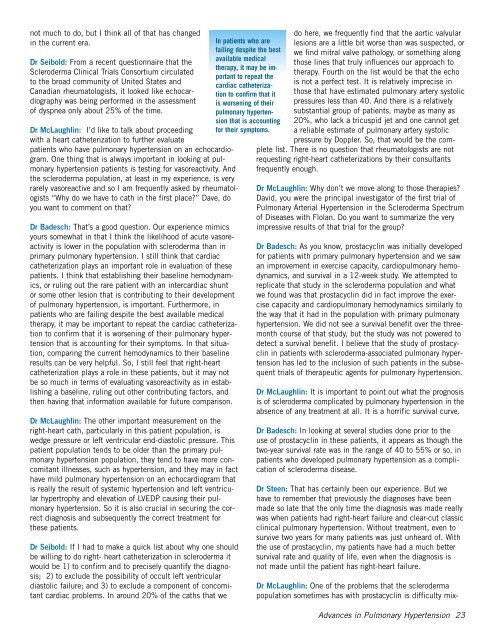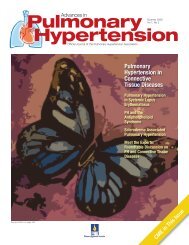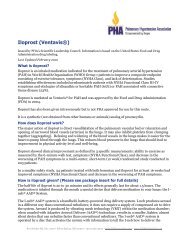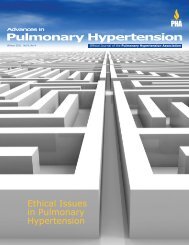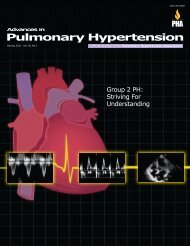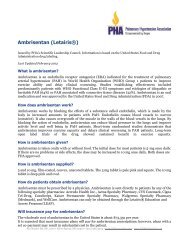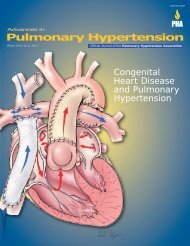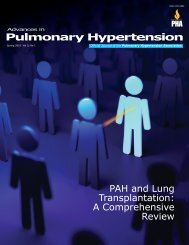Advances in Pulmonary Hypertension - PHA Online University
Advances in Pulmonary Hypertension - PHA Online University
Advances in Pulmonary Hypertension - PHA Online University
Create successful ePaper yourself
Turn your PDF publications into a flip-book with our unique Google optimized e-Paper software.
not much to do, but I th<strong>in</strong>k all of that has changed<br />
<strong>in</strong> the current era.<br />
Dr Seibold: From a recent questionnaire that the<br />
Scleroderma Cl<strong>in</strong>ical Trials Consortium circulated<br />
to the broad community of United States and<br />
Canadian rheumatologists, it looked like echocardiography<br />
was be<strong>in</strong>g performed <strong>in</strong> the assessment<br />
of dyspnea only about 25% of the time.<br />
Dr McLaughl<strong>in</strong>: I’d like to talk about proceed<strong>in</strong>g<br />
with a heart catheterization to further evaluate<br />
patients who have pulmonary hypertension on an echocardiogram.<br />
One th<strong>in</strong>g that is always important <strong>in</strong> look<strong>in</strong>g at pulmonary<br />
hypertension patients is test<strong>in</strong>g for vasoreactivity. And<br />
the scleroderma population, at least <strong>in</strong> my experience, is very<br />
rarely vasoreactive and so I am frequently asked by rheumatologists<br />
“Why do we have to cath <strong>in</strong> the first place?” Dave, do<br />
you want to comment on that?<br />
Dr Badesch: That’s a good question. Our experience mimics<br />
yours somewhat <strong>in</strong> that I th<strong>in</strong>k the likelihood of acute vasoreactivity<br />
is lower <strong>in</strong> the population with scleroderma than <strong>in</strong><br />
primary pulmonary hypertension. I still th<strong>in</strong>k that cardiac<br />
catheterization plays an important role <strong>in</strong> evaluation of these<br />
patients. I th<strong>in</strong>k that establish<strong>in</strong>g their basel<strong>in</strong>e hemodynamics,<br />
or rul<strong>in</strong>g out the rare patient with an <strong>in</strong>tercardiac shunt<br />
or some other lesion that is contribut<strong>in</strong>g to their development<br />
of pulmonary hypertension, is important. Furthermore, <strong>in</strong><br />
patients who are fail<strong>in</strong>g despite the best available medical<br />
therapy, it may be important to repeat the cardiac catheterization<br />
to confirm that it is worsen<strong>in</strong>g of their pulmonary hypertension<br />
that is account<strong>in</strong>g for their symptoms. In that situation,<br />
compar<strong>in</strong>g the current hemodynamics to their basel<strong>in</strong>e<br />
results can be very helpful. So, I still feel that right-heart<br />
catheterization plays a role <strong>in</strong> these patients, but it may not<br />
be so much <strong>in</strong> terms of evaluat<strong>in</strong>g vasoreactivity as <strong>in</strong> establish<strong>in</strong>g<br />
a basel<strong>in</strong>e, rul<strong>in</strong>g out other contribut<strong>in</strong>g factors, and<br />
then hav<strong>in</strong>g that <strong>in</strong>formation available for future comparison.<br />
Dr McLaughl<strong>in</strong>: The other important measurement on the<br />
right-heart cath, particularly <strong>in</strong> this patient population, is<br />
wedge pressure or left ventricular end-diastolic pressure. This<br />
patient population tends to be older than the primary pulmonary<br />
hypertension population, they tend to have more concomitant<br />
illnesses, such as hypertension, and they may <strong>in</strong> fact<br />
have mild pulmonary hypertension on an echocardiogram that<br />
is really the result of systemic hypertension and left ventricular<br />
hypertrophy and elevation of LVEDP caus<strong>in</strong>g their pulmonary<br />
hypertension. So it is also crucial <strong>in</strong> secur<strong>in</strong>g the correct<br />
diagnosis and subsequently the correct treatment for<br />
these patients.<br />
Dr Seibold: If I had to make a quick list about why one should<br />
be will<strong>in</strong>g to do right- heart catheterization <strong>in</strong> scleroderma it<br />
would be 1) to confirm and to precisely quantify the diagnosis;<br />
2) to exclude the possibility of occult left ventricular<br />
diastolic failure; and 3) to exclude a component of concomitant<br />
cardiac problems. In around 20% of the caths that we<br />
In patients who are<br />
fail<strong>in</strong>g despite the best<br />
available medical<br />
therapy, it may be important<br />
to repeat the<br />
cardiac catheterization<br />
to confirm that it<br />
is worsen<strong>in</strong>g of their<br />
pulmonary hypertension<br />
that is account<strong>in</strong>g<br />
for their symptoms.<br />
do here, we frequently f<strong>in</strong>d that the aortic valvular<br />
lesions are a little bit worse than was suspected, or<br />
we f<strong>in</strong>d mitral valve pathology, or someth<strong>in</strong>g along<br />
those l<strong>in</strong>es that truly <strong>in</strong>fluences our approach to<br />
therapy. Fourth on the list would be that the echo<br />
is not a perfect test. It is relatively imprecise <strong>in</strong><br />
those that have estimated pulmonary artery systolic<br />
pressures less than 40. And there is a relatively<br />
substantial group of patients, maybe as many as<br />
20%, who lack a tricuspid jet and one cannot get<br />
a reliable estimate of pulmonary artery systolic<br />
pressure by Doppler. So, that would be the complete<br />
list. There is no question that rheumatologists are not<br />
request<strong>in</strong>g right-heart catheterizations by their consultants<br />
frequently enough.<br />
Dr McLaughl<strong>in</strong>: Why don’t we move along to those therapies?<br />
David, you were the pr<strong>in</strong>cipal <strong>in</strong>vestigator of the first trial of<br />
<strong>Pulmonary</strong> Arterial <strong>Hypertension</strong> <strong>in</strong> the Scleroderma Spectrum<br />
of Diseases with Flolan. Do you want to summarize the very<br />
impressive results of that trial for the group?<br />
Dr Badesch: As you know, prostacycl<strong>in</strong> was <strong>in</strong>itially developed<br />
for patients with primary pulmonary hypertension and we saw<br />
an improvement <strong>in</strong> exercise capacity, cardiopulmonary hemodynamics,<br />
and survival <strong>in</strong> a 12-week study. We attempted to<br />
replicate that study <strong>in</strong> the scleroderma population and what<br />
we found was that prostacycl<strong>in</strong> did <strong>in</strong> fact improve the exercise<br />
capacity and cardiopulmonary hemodynamics similarly to<br />
the way that it had <strong>in</strong> the population with primary pulmonary<br />
hypertension. We did not see a survival benefit over the threemonth<br />
course of that study, but the study was not powered to<br />
detect a survival benefit. I believe that the study of prostacycl<strong>in</strong><br />
<strong>in</strong> patients with scleroderma-associated pulmonary hypertension<br />
has led to the <strong>in</strong>clusion of such patients <strong>in</strong> the subsequent<br />
trials of therapeutic agents for pulmonary hypertension.<br />
Dr McLaughl<strong>in</strong>: It is important to po<strong>in</strong>t out what the prognosis<br />
is of scleroderma complicated by pulmonary hypertension <strong>in</strong> the<br />
absence of any treatment at all. It is a horrific survival curve.<br />
Dr Badesch: In look<strong>in</strong>g at several studies done prior to the<br />
use of prostacycl<strong>in</strong> <strong>in</strong> these patients, it appears as though the<br />
two-year survival rate was <strong>in</strong> the range of 40 to 55% or so, <strong>in</strong><br />
patients who developed pulmonary hypertension as a complication<br />
of scleroderma disease.<br />
Dr Steen: That has certa<strong>in</strong>ly been our experience. But we<br />
have to remember that previously the diagnoses have been<br />
made so late that the only time the diagnosis was made really<br />
was when patients had right-heart failure and clear-cut classic<br />
cl<strong>in</strong>ical pulmonary hypertension. Without treatment, even to<br />
survive two years for many patients was just unheard of. With<br />
the use of prostacycl<strong>in</strong>, my patients have had a much better<br />
survival rate and quality of life, even when the diagnosis is<br />
not made until the patient has right-heart failure.<br />
Dr McLaughl<strong>in</strong>: One of the problems that the scleroderma<br />
population sometimes has with prostacycl<strong>in</strong> is difficulty mix-<br />
<strong>Advances</strong> <strong>in</strong> <strong>Pulmonary</strong> <strong>Hypertension</strong> 23


